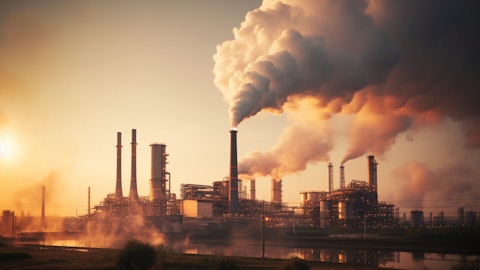Luxfer Holdings PLC (NYSE:LXFR) Q2 2025 Earnings Call Transcript July 30, 2025
Operator: Good morning. My name is Erica, and I will be your conference operator today. Welcome to the Luxfer Second Quarter 2025 Earnings Conference Call. [Operator Instructions] Now I will turn the call over to Kevin Grant, Vice President of Investor Relations and Business Development at Luxfer. Kevin, please go ahead.
Kevin Cornelius Grant: Thank you, Erica, and good morning, everyone. Welcome to Luxfer Second Quarter 2025 Earnings Conference Call. This morning, we’ll be reviewing Luxfer’s financial results for the second quarter ended June 29, 2025. I’m pleased to be joined today by Andy Butcher, our Chief Executive Officer; and Steve Webster, our Chief Financial Officer. Today’s webcast is accompanied by a presentation that can be accessed at luxfer.com. Please note, any references to non-GAAP financials are reconciled in the appendix of the presentation. Before we begin, a friendly reminder that any forward-looking statements made about the company’s expected financial results are subject to future risks and uncertainties. We undertake no obligation to update any forward-looking statements whether as a result of new information, future events or otherwise.

Please refer to the safe harbor statement on Slide 2 of today’s presentation for further details. During today’s call, we’ll be providing adjusted second quarter 2025 financial results, excluding the recently sold Graphic Arts business and the 2024 legal recoveries. Now let me turn the call over to Luxfer’s CEO. Please turn to Slide 3. Andy, please go ahead.
Andrew William John Butcher: Thank you, Kevin, and good morning, everyone. Thank you for joining us. Q2 was a very strong quarter for Luxfer, underscoring the strength of our core businesses, the resilience of our operating model and our ability to perform well in a dynamic environment. Adjusted earnings per share increased to $0.30, up 25% year-over-year and 30% sequentially, and adjusted EBITDA rose to $14 million. Sales growth was led by impressive ongoing momentum in our Elektron segment. Demand for MREs, flares and UGR-E platforms remained high, supported by defense restocking activity, sustained funding tailwinds and a buoyant aerospace market. We also saw sequential improvement in gas cylinders. While sales were modestly lower year-over-year, strong performance in space exploration, aerospace and First Response, helped offset ongoing softness in clean energy, which while an important part of our longer-term strategy, remains a little subdued in the near term.
These shifts in demand reflect well on the adaptability and diversity of our portfolio as the business continues to transition towards higher-value sectors where we are well positioned to deliver stronger profitability. We completed the divestiture of our Graphic Arts business in early July, a key deliverable stemming from our strategic portfolio review. This transaction allows us to sharpen our focus towards higher-margin opportunities within our core markets. We’ve also initiated an important relocation project in our composite cylinders business announcing the move of production from our Pomona, California site to our more automated Center of Excellence in Riverside, California. This is another key step in optimizing our footprint, generating savings of up to $4 million per annum through enhanced operational alignments.
Q&A Session
Follow Luxfer Holdings Plc (NYSE:LXFR)
Follow Luxfer Holdings Plc (NYSE:LXFR)
Receive real-time insider trading and news alerts
In summary, Q2 demonstrated strong execution, portfolio quality and the earnings power of our core businesses. With that, I’ll hand over to Steve, who will take you through the financials and our updated 2025 guidance. Steve?
Stephen M. D. Webster: Thanks, Andy, and good morning, everyone. Let’s turn to Slide 4 for a review of our consolidated financial results. In the second quarter, sales were $97.1 million, up 5.8% year-over-year reflecting continued strength across our core defense and aerospace markets. Adjusted EBITDA increased 14.8% to $14 million, delivering a 14.4% margin up from 12.5% in quarter 1, resulting in nearly 200 basis points of sequential margin improvement. Adjusted EPS rose to $0.30, up 25% year-over-year. We generated $1.2 million in cash from operations and net debt ended at $48.2 million with leverage at 0.9x. On the right, the sales bridge highlights a $2.2 million contribution from pricing, including targeted price actions in aerospace.
Foreign exchange was a $2 million tailwind and volume and mix added $1.1 million driven by strong MRE and flare demand and continued elevated aerospace shipments. For our adjusted EBITDA walk, the higher pricing was complemented by incremental volume and the higher value mix contribution of $2 million. These gains were partially offset by $2.4 million in headwinds primarily FX from the continued strengthening of sterling, residual inflation and elevated operating expenses. The majority of the higher OpEx reflects increased maintenance, utilities and overhead costs within Elektron, driven by improved throughput to support defense programs. For a full breakdown, please see the detailed waterfall in the appendix on Slide 12. With that, let’s move to Slide 5 for a closer look at Elektron’s Q2 performance.
Elektron delivered another strong quarter with sales increasing 19% year-over-year to $50.1 million adjusted EBITDA rose to $9.1 million, with margins expanding to 18.2%, reflecting favorable mix and disciplined execution, although partially tempered by the higher operating costs. Defense, first response and healthcare was a standout performer, up 43% from the prior year, and demand remains well above historical levels. In transportation, trends were mixed. We saw continued recovery in aerospace alloy volumes, auto catalysis improved sequentially but remains below pre 2023 levels and overall auto activity slowed. Specialty Industrial was also up modestly supported by increased demand for magnesium specialty powders. Overall, Q2 performance in Elektron reflected strong demand in our core end markets, ongoing operational execution and a healthy mix shift supporting top line growth and margin expansion.
With that, let’s turn to Slide 6 for our Gas Cylinders results. In quarter 2, gas cylinders delivered a solid sequential rebound with sales of $47 million, up 14% from the first quarter. While sales declined 6% year-over-year, we’re encouraged by improving momentum in key higher-margin segments. Adjusted EBITDA was $4.9 million, up 23.9% from the first quarter with margins improving to 10.4%, supported by further pricing execution of $2.5 million and disciplined cost control. Specialty Industrial improved 4%, driven by strength in calibration and electronics-related gas cylinders. Transportation also increased 4% led by solid demand in aerospace and especially space exploration, outpacing the ongoing pressures in the alternative fuel market.
Defense, first response and healthcare sales declined 15% year-over-year primarily due to the conclusion of the prior year U.S. Air Force SCBA program and short-term softness in medical cylinder contracts. That said, baseline demand in both areas remains steady. Overall, we view Q2 as a solid transition quarter for the segment. Improved mix and stronger contributions from aerospace, space exploration and electronics-related applications, supported sequential gains and margin expansion. This performance reflects a deliberate shift towards higher quality, higher-margin end markets. While clean energy volumes will remains soft, the flexibility of the portfolio has allowed us to adapt and focus on more profitable growth areas. Importantly, the recently announced relocation of composite cylinder production to our Riverside facility is expected to drive meaningful long-term benefits, streamlining our cost structure, enhancing operational efficiency and improving overall alignment across the business.
Let’s now move to Slide 7 for a review of our updated 2025 guidance. We’ve improved our full year guidance based on solid performance in the first half and continued strength in our order book. We have narrowed upwards the adjusted EPS range to $0.97 to $1.05 with adjusted EBITDA now between $49 million and $52 million. Projected free cash flow of $20 million to $25 million remains unchanged, but now incorporates the proceeds of the Graphic Arts sale which in turn helps fund the recently announced relocation project in our Gas Cylinders segment. We do now forecast low single-digit year-over-year sales growth versus 2024. Our confidence is supported by good momentum in defense and aerospace, including demand for MREs, UGR-Es and flares as well as a strong backlog.
We are maintaining tight control over costs and driving efficiency through site optimization initiatives. The impact of tariffs on our business has been modest to date, we are, though, seeing early signs of pressure in automotive affecting our Elektron business. This factor, when modeled with normal seasonality, is reflected in our latest guidance. We are pleased with our progress at the half year mark and cautiously optimistic about the full year outlook. Now I’d like to pass the call back to Andy.
Andrew William John Butcher: Thank you, Steve. Please turn to Slide 8 to review the highlights and achievements of the second quarter. We delivered strong earnings performance in Q2 with adjusted earnings per share up 25% year-over-year and sequential EBITDA margin improvement. This was driven by high revenues, a favorable product mix, disciplined pricing actions and effective cost control across the business. We completed the divestiture of Graphic Arts in early July, delivering on a key milestone from our strategic review. This move sharpens our focus on core high-margin platforms and enhances our portfolio alignment going forward. In our core markets, Elektron continued to perform well, led by MREs, UGR-Es and aerospace alloys.
We also saw a solid sequential uplift in gas cylinders with gains in specialty and space exploration offsetting clean energy headwinds. We further advanced our operational footprint strategy with the launch of the Pomona relocation project, moving composite cylinder production to our Riverside Center of Excellence. This initiative is expected to streamline our footprint, enhance automation and unlock long-term cost savings. And finally, our ability to pivot towards higher-value sectors such as aerospace, space exploration and defense has improved mix and earnings quality. This agility positions us well to capitalize on the opportunities ahead while enhancing profitability. So we are very proud of the progress the team delivered this quarter, and we remain focused on delivering long-term shareholder value.
I’ll now turn the call back to the operator for questions. Erica, please go ahead.
Operator: [Operator Instructions] And we’ll go to Steve Ferazani.
Stephen Michael Ferazani: I guess the surprise for me on the quarter was the nice bounce back in gas cylinders. Can you give a little bit more color on what drove the bounce back? And is that sustainable into the second half?
Andrew William John Butcher: Yes. Thanks, Steve. It was a really good quarter for us. We were very pleased with that and the momentum it takes us with into the second half of the year. The key things in gas cylinders was the sustained demand we saw for the first response product, which, of course, is the foundation for the business. Good sales in the specialty gas market for aluminum cylinders and then especially the further uplift that we saw in space exploration. We’re very positive about the developments in the space exploration field. Sales in Q2 were up on what was already a notable Q1. Indeed, Q2 revenues were at a record level. This is a demanding application, Steve, with operating at high tolerances, good margins. So we’re excited about the growth we are delivering in this segment. So I’ll say, yes, we believe we’ll see that ongoing bounce back in the Gas Cylinder business carry forward into the second half of the year.
Stephen Michael Ferazani: So any reason for why — I mean I got to ask, given the strength in the quarter, certainly was well above our EPS expectations. I don’t know whether it beat your internal — any reason you wouldn’t move the high end of the guidance range now?
Andrew William John Butcher: Yes. Look, as I said, we’re very pleased with Q2 performance after a solid Q1 and the progress, not just in space exploration that I mentioned, but particularly in defense and aerospace. So look, there’s much to be optimistic about looking ahead. Although there is still some uncertainty around tariffs, I think, and we have seen some softening in auto. So as Steve mentioned, we’ve modeled that in our guidance as well as some of the normal seasonality that we see. So yes, we are running just a little ahead of our initial expectations. We’ve acknowledged that with a modest uplift to the bottom end of the range. And I think importantly, our team are, of course, working really hard to deliver numbers that come into the upper end of the guidance range, we would really like to speak this at the end of Q2.
Stephen Michael Ferazani: Very fair. Can I ask about the — now with the consolidation into Riverside. We know that this is kind of an off year for the alternative fuels market, and people can look at Class 8 truck orders, it’s very explainable. We think we’re still bullish on where that market goes. Now you incorporate in what could be strong growth in space exploration, do you have the capacity at Riverside to meet what could be strong growth in both of those markets over the next decade?
Andrew William John Butcher: Absolutely, we do have the capacity in place, not just in Riverside, but also in our Canadian facility. Let me talk briefly about the Pomona consolidation because it’s very important in terms of value creation. We have been pleased with the Pomona business over the last few years and the performance of the products there. But we’ve got this opportunity to further improve the cylinders business overall by eliminating that duplication we have from 2 facilities just 30 miles apart. And it’s at a time the lease is soon to explore. So the timing is good. We can move into a more modern, more automated facility that we own and deliver these benefits in variable and fixed costs approaching $4 million per annum.
You also mentioned Clean Energy. Of course, that is a little subdued at the moment. But we’re actually quite bullish on the long-term picture for Clean Energy. We have continued to pick up a few nichey opportunities, particularly around hydrogen and CNG. Indeed, in the bulk gas space, we just converted the first tranche of a 7-module opportunity for our Hydrosphere trailer, so we’re optimistic about that long term. So it’s a good move, this consolidation to improve our cost base, and we still have ample capacity in Canada and in Riverside to address what I believe will continue to be a strong market in space exploration and growth to come in clean energy.
Stephen Michael Ferazani: Excellent. That’s helpful. You mentioned tariffs a little bit in the commentary. We’re starting to get a little more clarity around what it’s looking like moving forward? Has that changed how you think it impacts your business? And is that in guidance?
Stephen M. D. Webster: Yes. I mean, Steve, it’s certainly — I think we’ve said previously that we don’t think it has a significant direct impact on us, and that certainly has not changed. I think we gave some metrics in our 10-K last year about — roundabout sort of $20 million of sales or so either way between the effective market. But no, I think the main impact, as we’ve said before, would be on general macro factors. So particularly the automotive side that we mentioned previously, and we’re modeling lower automotive sales, as I said in my prepared remarks, and some of that may well be down to the impact of tariffs. But by and large, I think we’ve been generally unaffected. So we’re not seeing any significant change other than potentially what might happen to the macro.
Stephen Michael Ferazani: Got it. That’s helpful. Last one for me, given that a major milestone, in my opinion, closing out the sale of Graphic Arts, now as you start looking forward at the 2 sides of the business, it sounds like the main thrust of cash flow will be to debt reduction. Does that change longer term what you want these 2 businesses to look like? And what cash usage might be ’26, ’27?
Andrew William John Butcher: Thanks, Steve. Yes, so we’re very pleased to have delivered on the Graphic Arts sale and the — and that project was a key part of our strategic review. With that behind us, it does give us the opportunity to concentrate on — more on the growth opportunities we see with gas cylinders and Elektron we wouldn’t see any significant change to the investment that’s needed in those over that which we’ve seen previously. We have increased our capital investment this year fund both growth and automation above the levels we’ve seen in some of the earlier years. So we also have the opportunity within capital deployment to continue to look at not just debt reduction, but also share buyback where that makes sense. So pleased to have cleaned up the portfolio with the sale of Graphic Arts, does enable us to concentrate on those growth opportunities in the Elektron and Gas Cylinders.
Operator: And there are no more questions in the queue at this time. I’ll turn the call over to CEO, Andy Butcher, for final remarks.
Andrew William John Butcher: Thank you, Erica. Please turn to Slide 10. As we wrap up today’s call, let me talk specifically about why we believe Luxfer is a compelling long-term investment. We operate in growing mission-critical markets, including defense, aerospace, medical and First Response, where we hold leadership positions and serve bluechip customers who rely on our technology and performance. Our portfolio is increasingly focused on highly specialized high-value products, including technologies that enable lightweighting, high performance and premium pricing across niche applications. We’re demonstrating continued consolidation of our footprint with a new project to relocate our Pomona facility to Riverside, which will generate savings up to $4 million per annum.
Operationally, the Luxfer Business System continues to drive cost discipline and lean execution, and we are reviewing further opportunities for automation while simplifying our processes to strengthen our cost position. Financially, we remain disciplined and resilient. We’ve maintained leverage below 1x and continue to generate solid free cash flow to fund growth, dividends and buybacks and with a strong balance sheet and low leverage. Lastly, we retain our strategic optionality with multiple opportunities across both Elektron and gas cylinders we are positioned to deliver profitable growth as well as maintaining full flexibility to optimize our portfolio and unlock shareholder value. Overall, Luxfer provides an asymmetric value creation opportunity with strong fundamentals and opportunity to create long-term shareholder returns.
I’d like to close by thanking the entire Luxfer team for their exceptional execution and commitment, and thank you for your continued support. We look forward to updating you next quarter.
Operator: This concludes Luxfer’s Q2 2025 Earnings Call. A recording of this conference call will be available in about 2 hours. A link to a recording of this webcast will be available on the Luxfer’s website at www.luxfer.com. We thank you for joining, and please disconnect at any time.
Follow Luxfer Holdings Plc (NYSE:LXFR)
Follow Luxfer Holdings Plc (NYSE:LXFR)
Receive real-time insider trading and news alerts





